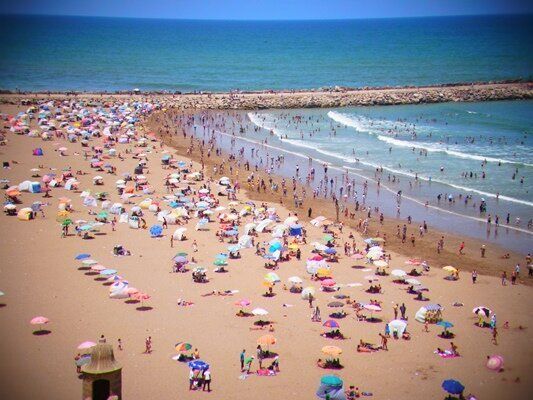It's the capital of a Kingdom and is home to 1.8 million people, still Morocco's third largest city, Rabat, leads a relatively anonymous existence on the country's Atlantic coast.
A short 45-minute train ride from Casablanca, Rabat is a place where Moroccan history spectacularly collides with modern life; and where the country's European roots wonderfully weave themselves through its African heritage.

Just taking a stroll through the closed quarters of the city, you'll see families play games on the local sandy beach - while a few minutes inland the brilliant-white, blue-trimmed homes of the 12th Century Oudayas Kasbah wind their way back from the ocean. It's a place of old and new; both co-existing and welcoming.
What to see

The bubbling European feel is hard to miss; a new tram system glides through relatively clear roads and the local marina is currently being redeveloped. Cafés spill out onto the pavement and polished furniture store windows twinkle under the sun. But just a short walk up the hill, the vibrance of today disappears into an enveloping history; the remains of the old Roman city appear out of the earthy hills in the Gardens of Sala Colonia in Chellah. This ancient site was almost completely destroyed during the Lisbon earthquake of 1755, but thankfully parts still stand, along with the medieval Muslim tombs buried deep in the sand.
On arrival, we climbed the huge stone steps, discovering little doorways and peering through what should have been windows. The stone walls stood bright and tall against the deep blue sky backdrop providing picture perfect opportunities. The glistening site is now home to a colony of storks, and they make their presence known.

On the other side of town, we discovered Rabat's colonial district and its impressive Art Deco architecture. The local post office still stands as it did back in the 1920s, surrounded by an old police station and courts built in the '30s. The wide avenues lined with palms provide a perfect shady pitstop for a coffee, mint tea or ice cream. Down the road, the semi-built Hassan Tower of 1196 stands tall amongst a sea of stone columns, while next door the beautifully constructed Mausoleum of King Hassan II and Prince Abdallah is guarded by traditionally-clad soldiers.

The Royal Palace and its grounds are often closed to the public but it is worth stopping outside to take in the magnificence and vastness of the complex. Inside there are the Royal Courts, staff housing and a school; plus acres of gardens.
The shopping

If I can give you one tip, it's leave plenty of room in your suitcase for shopping because Rabat's souks are home to a wealth of bargain buys. Leather shoes and handbags, patterned scarves, clay gifts and a whole range of olives and spices all occupy stalls across the narrow undercover paths.
The salesmen let you take your pick of the goods without feeling pressure (a world away from the hopeful cries of 'Bonjour monsieur? Madame?' as soon as you step into the souks in Marrakech). Here, there's a quiet, slowly-slowly movement around the busy market; it's quite extraordinary.
The food

Piles of fresh; fluffy couscous with honey-coated pumpkin and squash; tender melt-in-your-mouth lamb tagine; juicy chicken in a caramelised gravy - you won't go hungry here. Was it down with a café au lait or glass of the Moroccan red wine, it's distinct and great.
We found local eatery Le Ziryab, by trailing through the quiet Medina streets after-hours. Identified by a lonely doorway, you only have to tap the huge wooden door once to be allowed in and following a short walk through a secret corridor, you'll arrive in the most beautiful traditionally-decorated room. The lights are dim to set the mood and three musicians sit low against the pillars playing Moroccan folk tunes. The round tables sit in little coves, surrounded by soft velvet stools and candles; the perfect setting.
Indulge in some R&R

Just 25 minutes down the road sits Rabat's sister city, Salé - and it's here you'll find the luxurious L'Amphitrite Palace hotel. The Spa here invites day guests and locals in for couple's massages, as well as body scrub treatments, a Hammam and saunas - while the delicious infinity pool delicately lies in front of the ocean.
Where to stay

The L'Alcazar Riad in the centre of the city blew me away with its incredibly compact, but luxurious rooms. Perfect for everyone from honeymooners to friends to solo travellers, this type of hotel is traditional to Morocco; with an inner enclosed courtyard set up perfectly for sitting around reading or sipping mint teas, and a roof terrace where you can contemplate your day with a beer while looking over the Rabat rooftops.
The verdict

If there's one thing to remember about travelling to Morocco, it would be please don't bypass Rabat. Marrakesh may have the bustling bazaars and tourist comforts, while Casa' fame through Humphrey Bogart's 1940s movie draws in the millions; but Rabat's charm is its silence - this is a home to great history, eye-opening beauty, fresh produce and sense of strength and pride... but no one shouts about it. And that's what makes this place all the more special.
The deal
Flights from London Heathrow to Casablanca take three hours. Prices currently start from £217 on Royal Air Maroc. The train from Casablanca to Rabat will set you back 10 Euros.
Rooms at the L'Alcazar Riad start at 225 Euros per night.
Spa treatments at L'Amphitrite Palace can be booked online here.
Check out Visit Morocco for more information (http://www.visitmorocco.com/index.php/eng/)
PICTURE CREDIT: KAREN EDWARDS